The Intubation Tube Market is estimated to be valued at USD 3.1 billion in 2025 and is projected to reach USD 6.0 billion by 2035, registering a compound annual growth rate (CAGR) of 6.8% over the forecast period.
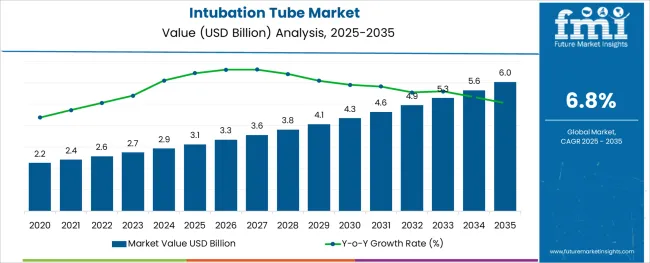
The intubation tube market is expanding as critical care procedures and respiratory interventions increase globally. Clinical practice trends and healthcare facility reports have identified the growing need for reliable airway management solutions in emergency and surgical settings. The rise in hospital admissions due to respiratory disorders and trauma cases has fueled the use of intubation tubes as life-saving medical devices.
Healthcare providers have focused on improving patient safety during ventilation procedures which has accelerated the adoption of high-quality intubation tubes. Product innovation has improved the material quality and flexibility of these tubes enhancing clinician comfort during insertion and minimizing patient trauma.
The market is expected to grow further as awareness of airway management protocols expands in developing regions. Segmental growth is anticipated to be led by Regular Intubation Tubes for their general use in clinical practice, Orotracheal Tubes as the preferred route for airway access, and Emergency Treatment as the dominant application driven by urgent care needs.
The market is segmented by Product Type, Route Type, and Application and region. By Product Type, the market is divided into Regular Intubation Tube Market, Reinforced Intubation Tube Market, Preformed Intubation Tube Market, and Double lumen Intubation Tube Market. In terms of Route Type, the market is classified into Orotracheal Tube and Nasotracheal Tube. Based on Application, the market is segmented into Emergency Treatment, Therapy, and Other Applications. Regionally, the market is classified into North America, Latin America, Western Europe, Eastern Europe, Balkan & Baltic Countries, Russia & Belarus, Central Asia, East Asia, South Asia & Pacific, and the Middle East & Africa.
The market is segmented by Product Type, Route Type, and Application and region. By Product Type, the market is divided into Regular Intubation Tube Market, Reinforced Intubation Tube Market, Preformed Intubation Tube Market, and Double lumen Intubation Tube Market. In terms of Route Type, the market is classified into Orotracheal Tube and Nasotracheal Tube. Based on Application, the market is segmented into Emergency Treatment, Therapy, and Other Applications. Regionally, the market is classified into North America, Latin America, Western Europe, Eastern Europe, Balkan & Baltic Countries, Russia & Belarus, Central Asia, East Asia, South Asia & Pacific, and the Middle East & Africa.
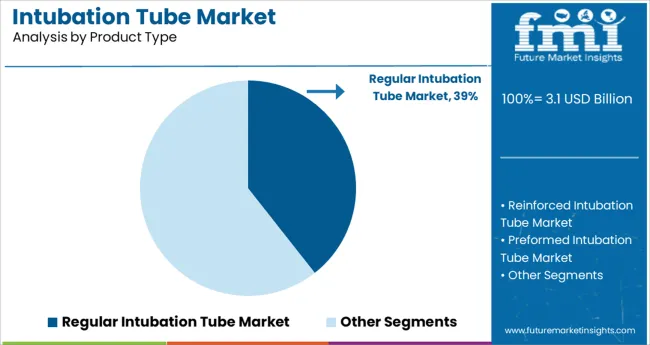
The Regular Intubation Tube segment is projected to hold 39.4% of the intubation tube market revenue in 2025 sustaining its position as the leading product type. This segment has been driven by the widespread use of regular intubation tubes in routine clinical procedures where quick and reliable airway access is essential.
Medical teams have preferred these tubes for their simplicity ease of insertion and compatibility with most ventilation equipment. Regular intubation tubes have remained a first-line choice in general anesthesia intensive care and emergency care settings.
Additionally their availability in various sizes and materials has supported use across all age groups. As healthcare providers continue to standardize airway management practices the Regular Intubation Tube segment is expected to maintain strong demand.
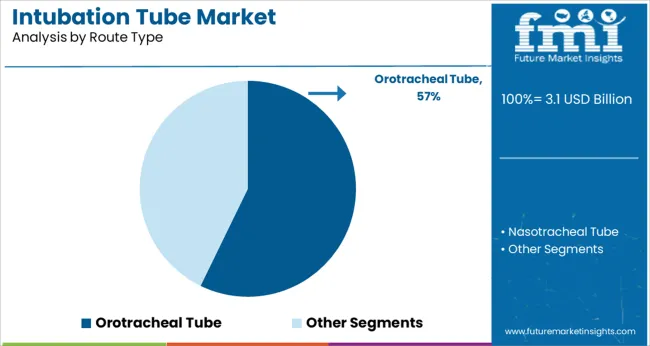
The Orotracheal Tube segment is expected to account for 57.2% of the intubation tube market revenue in 2025 making it the most widely used route type. This segment has expanded as orotracheal intubation has become the primary technique for securing the airway during surgery trauma management and critical care.
Clinicians have relied on orotracheal tubes for their accessibility and effectiveness in establishing a patent airway in time-sensitive situations. Medical guidelines have consistently supported orotracheal intubation as the preferred route for both elective and emergency procedures due to its ease of placement and minimal complications when performed correctly.
As critical care units and emergency departments prioritize rapid airway management the Orotracheal Tube segment is projected to sustain its leadership in the market.
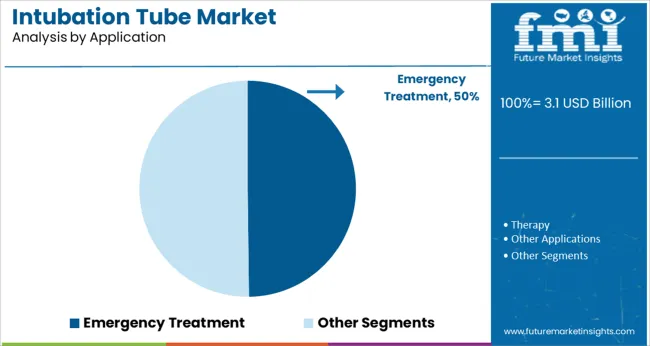
The Emergency Treatment segment is projected to contribute 49.8% of the intubation tube market revenue in 2025 positioning it as the leading application area. This segment has grown due to the increasing demand for immediate airway support during trauma respiratory failure and cardiac arrest cases.
Emergency responders and hospital teams have emphasized the importance of rapid intubation to prevent hypoxia and stabilize critically ill patients. The widespread use of intubation tubes in ambulances emergency rooms and critical care transport has further reinforced the segment’s growth.
Clinical training programs have enhanced the skill level of emergency care providers in airway management leading to faster response times and improved patient outcomes. As emergency care systems expand globally the Emergency Treatment segment is expected to remain the dominant application for intubation tubes.
As per the Intubation Tube Market research by Future Market Insights - market research and competitive intelligence provider, historically, from 2020 to 2024, the market value of the Intubation Tube Market increased at around 5.6% CAGR.
Intubation Tube Market are in high demand due to an increase in surgeries. There has been a lowered risk of infection linked with tubes while also enhancing product safety owing to technological advancements in endotracheal tubes.
Ventilator-associated pneumonia is more common in patients who have been on an Intubation Tube Market for over 48 hours. As a result, a large number of companies are working on antibacterial and anti-coagulant coatings to help reduce ventilator-associated pneumonia.
Also, the Coated Endotracheal Tube Market has been increasing owing to the rising prevalence of ventilator-associated pneumonia, thereby supporting market growth.
As a consequence, technical advancements in Intubation Tube Market, as well as the surge in the geriatric population that is more susceptible to a number of chronic conditions, will aid market growth throughout the projection period.
Orotracheal intubation is expected to account for a considerable revenue share, owing to the increased penetration in emergency situations such as catastrophic injuries and cardiac arrests.
Orotracheal intubation is becoming more popular among patients due to its superior comfort and applicability. The increased need for less painful and simple surgeries will further propel the market forward.
The rising frequency of chronic respiratory disease, the growing incidence of ventilator-associated pneumonia, increasing road accidents and trauma injuries, increasing prevalence of cancer, lung injuries, cardiovascular diseases, and technological developments in Intubation Tube Market are driving the market growth.
Owing to the increased occurrence of road accidents around the world, emergency treatment applications of Intubation Tube Market are expected to gain significant traction.
More than 1.3 Million people die in road traffic accidents per year, according to the World Health Organization (WHO). The industry's growth will be influenced by the growing need to address poor ventilation and the rising number of occurrences of respiratory disorders.
The hospitals which have acquired infections such as ventilation-associated pneumonia are driving the growth of the Intubation Tube Market. In ICU patients are at utmost risk of dying due to procedure complications or various other reasons, one of the reasons being critical illness via secondary processes which include nosocomial infection.
The second most common nosocomial infection is pneumonia in critically ill patients to put into perspective which affects 27% of the critically ill patients. Nearly 86% of nosocomial pneumonia is caused by ventilator-associated pneumonia.
Ventilator-associated pneumonia-related mortality has been estimated to be between 0% and 50%. When it comes to assessing attributable mortality, different studies have produced varied conclusions, owing to the fact that the populations studied are so diverse.
North America accounts for over 30% of the global Intubation Tube Market. It is primarily due to the development and evolution of healthcare facilities, the growing geriatric population, the rising prevalence of chronic conditions, the growing acceptance of analytical solutions, technical improvements, and the existence of key players.
Over the projected period, the market in Asia Pacific is expected to develop at the fastest rate. The sales of Intubation Tube in the region is expected to rise as the region's elderly population ages also rises.
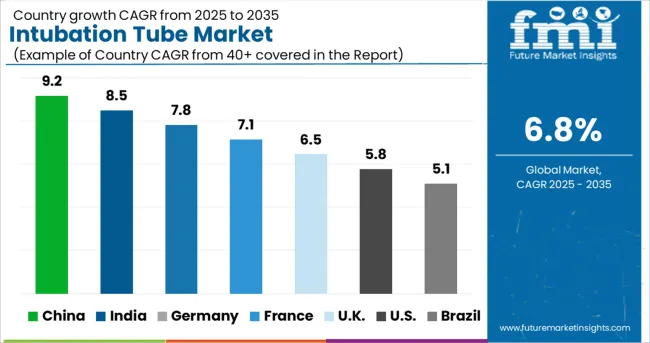
USA contributed over 30% to the global Intubation Tube Market revenue in 2024. The surge in tracheal diseases including tracheal stenosis, bronchial tumor, and tracheobronchomalacia have escalated the need for Intubation Tube Market demand in the country.
According to National Cancer Institute, lung and bronchus cancer in 2025, new lung and bronchial cancer cases in the USA is estimated at 236, 740 which is 12.3% of all new cancer cases. With this the death toll for this disorder will tally to 130,180, equivalent to 21.4% of all cancer-led deaths in the country.
Revenue through the orotracheal route type is forecasted to grow at the higher CAGR of over 7.2% during 2025 to 2035. Orotracheal incubation is commonly used in cases of respiratory or cardiovascular arrest, poor oxygenation or ventilation and current or projected airway obstruction.
As a result, orotracheal tube demand has increased over the years, and the route type is expected to grow at a strong rate over the projection period.
Intubation Tube Market revenue through emergency treatment application remains the highest, with an estimated 7.3% CAGR during the forecast period. The majority of emergency treatment comes from the rising occurrences of traffic accidents, , and increased frequency of emergency conditions such as cardiac arrest and respiratory, airway obstruction, and inadequate breathing.
Over the projection period, key drivers for Intubation Tube Market growth through emergency treatment include an increase in the number of surgeries performed, a surge in the frequency of chronic respiratory disorders and ageing population.
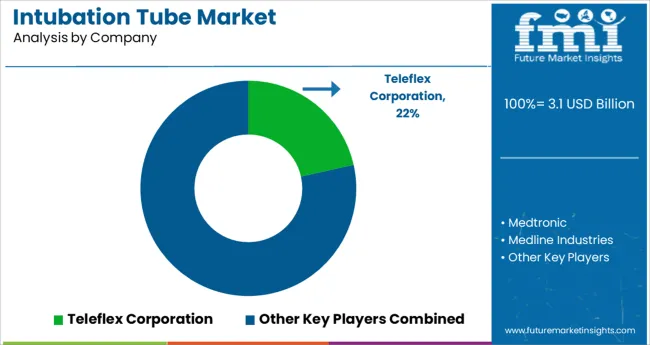
The growing adoption of modern healthcare technology for enhanced healthcare is a key factor influencing the competitive character of the industry. In addition, large players frequently combine mergers and acquisitions with new product releases in order to maintain intubation tube market share and broaden their product portfolio.
Some of the recent developments of Intubation Tube Manufacturers are as follows:
| Attributes | Details |
|---|---|
| Forecast Period | 2025 to 2035 |
| Historical Data Available for | 2020 to 2024 |
| Market Analysis | million for Value |
| Key Regions Covered | North America; Europe; Asia Pacific; Middle East & Africa; Latin America |
| Key Countries Covered | United States, Canada, Brazil, Mexico, Germany, UK, France, Spain, Italy, Russia, China, Japan, South Korea, India, Australia, South Africa, Saudi Arabia, UAE and Israel. |
| Key Market Segments Covered | Type, Route Type, Application, Region |
| Key Companies Profiled | Teleflex Corporation; Medtronic; Medline Industries; Venner Medical; Sonoma Pharmaceutical; Hospiteknik Healthcare; Armstrong Medical; Airway Innovations; Smiths Group; ConvaTec, Inc.; DePuy Synthes; Stryker; Zimmer Biomet; Smith Nephew; Orthofix; Hydromer |
| Pricing | Available upon Request |
The global intubation tube market is estimated to be valued at USD 3.1 billion in 2025.
It is projected to reach USD 6.0 billion by 2035.
The market is expected to grow at a 6.8% CAGR between 2025 and 2035.
The key product types are regular intubation tube market, reinforced intubation tube market, preformed intubation tube market and double lumen intubation tube market.
orotracheal tube segment is expected to dominate with a 57.2% industry share in 2025.






Full Research Suite comprises of:
Market outlook & trends analysis
Interviews & case studies
Strategic recommendations
Vendor profiles & capabilities analysis
5-year forecasts
8 regions and 60+ country-level data splits
Market segment data splits
12 months of continuous data updates
DELIVERED AS:
PDF EXCEL ONLINE
Tube and Core Market Size and Share Forecast Outlook 2025 to 2035
Tube Tester Market Size and Share Forecast Outlook 2025 to 2035
Tube Rotator Market Size and Share Forecast Outlook 2025 to 2035
Tuberculosis Therapeutics Market Size and Share Forecast Outlook 2025 to 2035
Tube Laminating Films Market Size and Share Forecast Outlook 2025 to 2035
Tube Filling Machine Market Size and Share Forecast Outlook 2025 to 2035
Tube Ice Machine Market Size and Share Forecast Outlook 2025 to 2035
Tube Closures Market Size and Share Forecast Outlook 2025 to 2035
Tube Sealing Machines Market Analysis by Tube type, Technology type, End User, and Region through 2025 to 2035
Tuberculous Meningitis Treatment Market - Demand & Innovations 2025 to 2035
Tube Feeding Formula Market Analysis by Product Type, Form, End User, Primary Condition and Distribution Channel Through 2035
Market Share Distribution Among Tube Filling Machine Manufacturers
Competitive Breakdown of Tube Sealing Machines Providers
Breaking Down Market Share in Tube Laminating Films
Competitive Overview of Tube and Core Market Share
Tube and Dressing Securement Products Market
Tuberculosis Diagnostics Market
Tubes, Bottles and Tottles Market
U-Tube Viscometer Market Size and Share Forecast Outlook 2025 to 2035
Nontuberculous Mycobacterium Treatment Market

Thank you!
You will receive an email from our Business Development Manager. Please be sure to check your SPAM/JUNK folder too.
Chat With
MaRIA